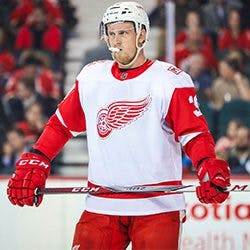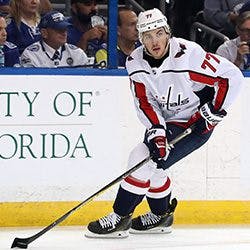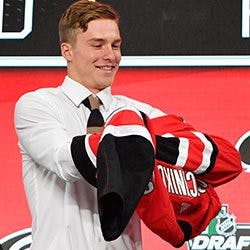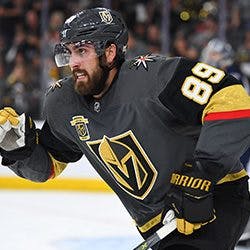Ranking Fantasy Hockey Right Wingers By Tiers (6-9)


These tier posts breakdown our positional rankings to help you better understand who you should be targeting in your fantasy draft and when you should be going after them. Here are our top right wingers for the 2018-19 season, tiers 6-9. You can find the rest of our positional tiers here:
Tier 6
J.T. Miller (TBL), Kyle Palmieri (NJD), Travis Konecny (PHI), Jason Zucker (MIN), Anthony Mantha (DET), Reilly Smith (VGK)

Palmieri would have been on pace for another 30-goal season had he not missed 20 games with a broken foot. His mediocre assist totals make it unlikely that he’ll break 60 points, but his ability to put the puck in the net and his usage secure him a spot in our sixth tier. Konecny seems poised to build upon the 47 points he registered last season as a 20-year-old and is one of the top breakout candidates heading into this fantasy season. However, like Miller, his value and production are too closely tied to his linemates to justify ranking him any higher.
Zucker was able to ride a hot start to a career high 33 goals last season. While his shooting percentage was a tad high last year, the 222 shots he registered suggest he has a real shot of topping 30 goals again this season. A crowded Minnesota top-nine hampers Zucker’s usage enough to knock him out of our top five tiers. Mantha was able to put up 24 goals last year on what was an abysmal Red Wings’ team. Mantha’s usage and production should continue to rise in this his age 24 season, especially given what is expected to be a prolonged absence of Henrik Zetterberg to start the season. There’s an extra 20 minutes of ice time to be divvied up for the Red Wings’ forwards, and you can bet Mantha will be one of the beneficiaries.
Smith was one of the many overperformers on the Vegas Golden Knights last season. A high on ice shooting percentage of 12.0% helped Smith tally a remarkable 38 assists, 30 coming at even strength. Once the impending regression sets in you can expect Smith’s point range to fall back into the low 50s.
Tier 7
Teuvo Teravainen (CAR) , Sam Reinhart (BUF), Josh Bailey (NYI), Brendan Gallagher (MTL), Mats Zuccarello (NYR), T.J. Oshie (WSH)

Though he was able to pot 25 goals last season as a 22-year-old, Reinhart was only able to muster 50 points despite playing most of the season alongside Jack Eichel. With the loss of centreman Ryan O’Reilly and the addition of wingers Skinner and Connor Sheary, it’s likely the Sabres will attempt to transition Reinhart into a full-time centre, killing any chance he has of spending another year with Eichel. While the loss of Tavares is sure to decimate the production of Josh Bailey, we can only let a 71-point guy slide so far. His Thornton-esque goal/assist splits (18/53) hamper his value even further.
Gallagher is the last reigning 30-goal scorer on our list. As far as his projections for this season go, the best indicator Gallagher has going for him is the career-high 278 shots he put up last season. His lack of playmaking makes it unlikely that he’ll break 60 points, but an uptick in ice time (16:09 ATOI last year) could be enough to get him back-to-back 30 goal seasons. Zuccarello is a reliable bet to hit 50 points again this season, but he’ll need an uncharacteristically high shooting percentage (like the 15.7% he registered in 2015-16) to have a shot at breaking 20 goals. A lackluster Rangers’ team should keep Zuccarello’s usage sky-high.
Oshie’s shooting percentage predictably fell off from the 23.1% he posted in 2016-17 to 14.2% last year, leading to a 15-goal drop despite playing in six more games. He’ll need another astronomical shooting percentage if he wants to outproduce some of the guys ranked above him on this list, but given his ice time and role on the Caps’ top powerplay unit, he has a comfortable floor of about 50 points.
Tier 8
Andrei Svechnikov (CAR), Patric Hornqvist (PIT), Alex Debrincat (CHI), James Neal (CGY), Tyler Toffoli (LAK), Nick Bjugstad (FLA)

Hornqvist offers just the opposite of Svechnikov; a very sturdy floor but capped ceiling. Assuming his role stays the same, Horqnvist will almost certainly churn out another season of goal scoring in the mid-to-high 20s and a point total in the low 50s. The potential to slide down the depth chart means there is only risk and no real upside to this pick, so don’t rely on him as anything more than a filler at the bottom of your roster. Debrincat scored a remarkable 28 goals last season despite playing under 15 minutes a game. One would assume that he’s earned himself a top-six role this year, though head coach Joel Quenneville has been hesitant to loosen the reigns on the young winger. While it will be hard for Debrincat to duplicate his 15.5% shooting percentage, an uptick in ice time, and presumably shots taken, could help mitigate any regression there.
Neal should have no problem getting back to 25 goals with the Flames this year, but his lack of playmaking ability will make it hard for him to get back above 50 points. Toffoli was able to register 24 goals on 251 shots in just 16 minutes of ice time per game last year. A slight bump up in shooting percentage as well as some more ice time could help him flirt with 30 goals, but mediocre assist totals suggest 60 points is out of reach. Bjugstad dropped down our ranks considerably after the acquisition of Mike Hoffman crowded the Panthers’ top-six. He was only able to muster 49 points in a full season spent on a line with Aleksander Barkov and Evgenii Dadonov, and it’s unclear where he’ll slot into the depth chart come opening night. While the 230 shots on goal are an encouraging sign, his 9.1% career shooting percentage makes a 30-goal season unlikely.
Tier 9
Dustin Brown (LAK), Charlie Coyle (MIN), Yanni Gourde (TBL), Alex Tuch (VGK), Kyle Okposo (BUF)

Coyle couldn’t match the 56 points he put up in 2016-17 last season, mustering just 37 points in 66 games. The injuries certainly didn’t help, but Coyle’s biggest obstacle on the road back to 50 points will be the depth of the Wild up front. The skillset is there but he needs a serious boost in ice time if he wants to have a bounce-back season.
Gourde had a remarkable 2017-18 season, posting 64 points and 25 goals on just 136 shots. That 18.4% shooting percentage is bound to come back down to Earth this season, with his 11.8% on ice shooting percentage likely to follow suit. He’ll need a boost in ice time, specifically with the man advantage, to offset the impending regressions.
Tuch was one of the few Golden Knights who actually underperformed last season. The 21-year-old registered 171 shots but netted only 15 goals (8.8%) and had a lowly on ice shooting percentage of just 7.7%. He’s bound to get an uptick in ice time after playing just 15 minutes a game last season, and could easily end up with 25 plus goals come season’s end. As expected, Okposo has failed to replicate the success he had with the Islanders in the past two seasons as a Sabre. He still managed to put up 45 and 44 points in those two seasons with some subpar linemates, and could very well end up on a line with Eichel and Skinner once October rolls around. A solid floor with some considerable upside is hard to find this far down the draft board, so keep an eye out for Okposo in the last few rounds of your fantasy draft.


